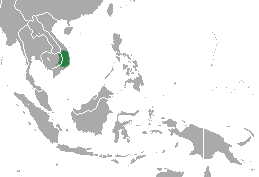Facts About Black-shanked douc
The black-shanked douc, an endangered primate, primarily inhabits the forests of eastern Cambodia, with smaller populations located in Vietnam. These monkeys are easily identifiable by their distinctive greyish-blue faces. Although the exact global population is unknown, it is estimated that about 23,000 individuals reside in Cambodia's Keo Seima Wildlife Sanctuary. In contrast, Vietnam hosts a significantly smaller population, comprising approximately 500-600 individuals.
These arboreal creatures primarily consume leaves, which also aid in maintaining their hydration. They thrive in evergreen forests, where they tend to form larger groups and live at higher densities. However, they can also be found in semi-evergreen and mixed deciduous forests, although these environments may not provide as much food. Occasionally, they inhabit dry deciduous dipterocarp forests, particularly when preferred forest types are unavailable.
The social structure of black-shanked doucs varies depending on the habitat. In less optimal areas, they form smaller groups. Their social units can include one-male groups, bands of several one-male units, bachelor groups, and solitary males. Typically, a one-male unit consists of a male, several females, and their offspring. These monkeys exhibit a fission-fusion social system, meaning that smaller groups often merge into larger bands, especially during the wet season. The largest band ever recorded comprised 26 individuals.
When it comes to their diet, black-shanked doucs are quite selective. They primarily consume seeds and leaves, favoring specific plant species. Their diet mainly consists of a few positively identified plant species, with a significant portion derived from just a handful of these plants.

 China
China